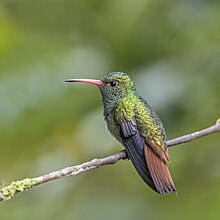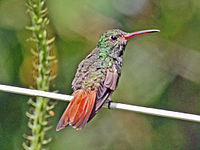| Rufous-tailed hummingbird | |
|---|---|

| |
| Male A. t. fuscicaudata, Colombia | |
| Conservation status | |
 Least Concern (IUCN 3.1) | |
| CITES Appendix II (CITES) | |
| Scientific classification | |
| Domain: | Eukaryota |
| Kingdom: | Animalia |
| Phylum: | Chordata |
| Class: | Aves |
| Clade: | Strisores |
| Order: | Apodiformes |
| Family: | Trochilidae |
| Genus: | Amazilia |
| Species: | A. tzacatl |
| Binomial name | |
| Amazilia tzacatl (de la Llave, 1833) | |

| |
| Range | |
The rufous-tailed hummingbird (Amazilia tzacatl) is a medium-sized hummingbird in the "emeralds", tribe Trochilini of subfamily Trochilinae. It is found from east-central Mexico through Central America and Colombia into Ecuador and Venezuela.
Taxonomy
The rufous-tailed hummingbird was formally described in 1833 by the Mexican naturalist Pablo de La Llave. He placed it in the genus Trochlilus and coined the binomial name Trochilus tzacatl. The rufous-tailed hummingbird is now placed in the genus Amazilia and was introduced in 1843 by the French naturalist René Lesson. The genus name comes from the Inca heroine in Jean-François Marmontel's novel Les Incas, ou la destruction de l'Empire du Pérou. The specific epithet is from Aztec mythology: Tzacatl was a warrior chief.
The rufous-tailed hummingbird has these five recognized subspecies:
- A. t. tzacatl (La Llave, 1833)
- A. t. handleyi Wetmore, 1963
- A. t. fuscicaudata (Fraser, 1840)
- A. t. brehmi Weller & Schuchmann, 1999
- A. t. jucunda (Heine, 1863)
A. t. handleyi was originally described as a separate species, the Escudo hummingbird. At least one author treated the rufous-tailed hummingbird and the chestnut-bellied hummingbird (Saucerottia castaneiventris) as a superspecies; the latter was included in the genus Amazilia at that time, but the two are now known to not be closely related. Some authors have doubted that A. t. fuscicaudata should be a separate subspecies.
Description
The rufous-tailed hummingbird is 9 to 11 cm (3.5 to 4.3 in) long and weighs approximately 5 g (0.18 oz). The adult male of the nominate subspecies has a green head and upperparts except for chestnut-brown lores and uppertail coverts. The tail is also mostly chestnut-brown, giving the species its English name; the feathers' outer webs and tips are bronze green. The throat, upper breast, and sides are green; the throat feathers sometimes have thin white edges giving a scalloped effect. The lower breast is gray, the belly white, and the undertail coverts chestnut-brown. The adult female's lower breast is a paler gray than the male's and the scalloping on the throat is more pronounced. Juveniles have a cinnamon wash to the lower breast and sides and the feathers of the lower back and rump have narrow cinnamon tips. The outer half of the bill's maxilla is black and the inner half red; the mandible is red with a black tip.
The song is "varied, high, thin, squeaky chirping, tsi, tsi-tsi-tsit tsi-tsitsi tsi-si-si." Its calls are "a fairly hard, smacking tchik-tchik...or...tchi tchi..., at times repeated insistently" and "dry, hard chips often run into a rattling chirr-rr-rr-rr-rr".
A. t. handleyi has the same color pattern as the nominate but is significantly larger and darker. A. t. fuscicaudata is smaller than the nominate and has a shorter and stouter bill. A. t. jucunda's maxilla is pinkish brown rather than black; its belly is a darker gray than the nominate's and the bronze green on the tail is narrower. A. t. brehmi is similar to jucunda and fuscicaudata but has longer wings and tail. It has a longer bill than fuscicaudata and reduced green on the tail like jucunda.
Distribution and habitat
The subspecies of the rufous-tailed hummingbird are found thus:
- A. t. tzacatl, from the eastern Mexican states of Veracruz and Oaxaca south through Belize, Guatemala, Honduras, Nicaragua, and Costa Rica into most of Panama (It apparently skips El Salvador.)
- A. t. handleyi, Isla Escudo de Veraguas off the Caribbean coast of northwestern Panama
- A. t. fuscicaudata, the Cauca River and Magdalena River valleys of northern and western Colombia east into western Venezuela's Lara and Táchira states
- A. t. brehmi, the upper Güiza River in Colombia's Nariño Department
- A. t. jucunda, from Chocó Department in western Colombia south through western Ecuador to Loja Province
The South American Classification Committee (SACC) of the American Ornithological Society extends the range of A. t. jucunda into Peru.
The rufous-tailed hummingbird inhabits open, non-forested, landscapes such as clearings, gardens, and the edges of forest. It is also found in low, young, brushy, secondary forests. It frequently comes to feeders. In elevation, the rufous-tailed hummingbird ranges from sea level to 1,200 m (3,900 ft) in Mexico, to 1,850 m (6,100 ft) in Costa Rica, 1,800 m (5,900 ft) in Colombia, and 1,700 m (5,600 ft) in Venezuela. It is found as high as 2,500 m (8,200 ft) in Ecuador but that elevation is thought to be local or seasonal.
Behavior
Feeding
Like most hummingbirds, the rufous-tailed feeds on nectar and small insects. It is common at sugar water feeders and often seen in coffee and banana plantations. It is extremely territorial and aggressive at feeding sites such as flower patches and feeders, from which it chases other hummingbirds and large insects.
Breeding
The rufous-tailed hummingbird is polygynous. Though it is aggressive while feeding, the species sometimes nests in loose colonies. Its breeding season varies widely across its range but is within the February to November span. The female is entirely responsible for nest building, incubation of eggs, and care of nestlings. She lays two white eggs in a compact cup nest constructed from plant fibers, leaves, and spiderwebs covered with lichens and mosses. It is typically placed up to 6 m (20 ft) high on a thin horizontal twig. Incubation takes 15 to 19 days, and fledging another 18 to 22 days.
Status
The IUCN has assessed the rufous-tailed hummingbird as being of Least Concern. It has a very large range and a population estimated at more than five million mature individuals, though that number is thought to be decreasing. The species might actually benefit from human activity, as deforestation provides open spaces. The species frequents coffee and banana plantations and readily comes to feeders.
Gallery
-
 Rufous-tailed hummingbird
Rufous-tailed hummingbird
-
 Rufous-tailed hummingbird in Panama
Rufous-tailed hummingbird in Panama
-
At La Selva, Costa Rica
References
- ^ BirdLife International (2016). "Rufous-tailed Hummingbird Amazilia tzacatl". IUCN Red List of Threatened Species. 2021: e.T22730168A167102277. doi:10.2305/IUCN.UK.2021-3.RLTS.T22730168A167102277.en. Retrieved 15 February 2022.{{cite iucn}}: |volume= / |date= mismatch, |date= / |doi= mismatch (help)
- "Appendices | CITES". cites.org. Retrieved 2022-01-14.
- de la Lave, Pablo (1833). "Zoologica". Registro trimestre, ó, Colección de historia, literatura, ciencias y artes (in Spanish and Latin). 2 (5): 39–50 .
- Lesson, René (1843). "Ornithologie: Complément à l'histoire naturelle des oiseaux-mouches". L'Echo du Monde Savant (in French). Part 2 (32). Col. 755–758 (757).
- ^ Gill, Frank; Donsker, David; Rasmussen, Pamela, eds. (August 2022). "Hummingbirds". IOC World Bird List Version 12.2. International Ornithologists' Union. Retrieved 13 September 2022.
- Jobling, James A. (2010). The Helm Dictionary of Scientific Bird Names. London: Christopher Helm. pp. 43, 394. ISBN 978-1-4081-2501-4.
- Remsen, J. V., Jr., J. I. Areta, E. Bonaccorso, S. Claramunt, A. Jaramillo, D. F. Lane, J. F. Pacheco, M. B. Robbins, F. G. Stiles, and K. J. Zimmer. Version 31 January 2022. A classification of the bird species of South America. American Ornithological Society. https://www.museum.lsu.edu/~Remsen/SACCBaseline.htm retrieved February 1, 2022
- ^ Reich, S. K. (2020). Rufous-tailed Hummingbird (Amazilia tzacatl), version 1.0. In Birds of the World (T. S. Schulenberg, Editor). Cornell Lab of Ornithology, Ithaca, NY, USA. https://doi.org/10.2173/bow.rtlhum.01 retrieved February 15, 2022
- Plenge, Manuel A.; Schulenberg, Thomas S.; Valqui, Thomas (December 11, 2021). "Species lists of birds for South American countries and territories: Peru". South American Classification Committee of the American Ornithological Society.
External links
- Photo-Medium Res; Article chandra.as.utexas.edu–"Birds of Ecuador"
- Rufous-tailed hummingbird photo gallery at VIREO (Drexel University)
| Taxon identifiers | |
|---|---|
| Amazilia tzacatl |
|
| Trochilus tzacatl | |
- IUCN Red List least concern species
- Amazilia
- Birds of the Yucatán Peninsula
- Birds of Mexico
- Birds of Belize
- Birds of Guatemala
- Birds of Honduras
- Birds of Nicaragua
- Birds of Costa Rica
- Birds of Panama
- Hummingbird species of Central America
- Hummingbird species of South America
- Birds of Colombia
- Birds of Ecuador
- Birds of Venezuela
- Birds described in 1833